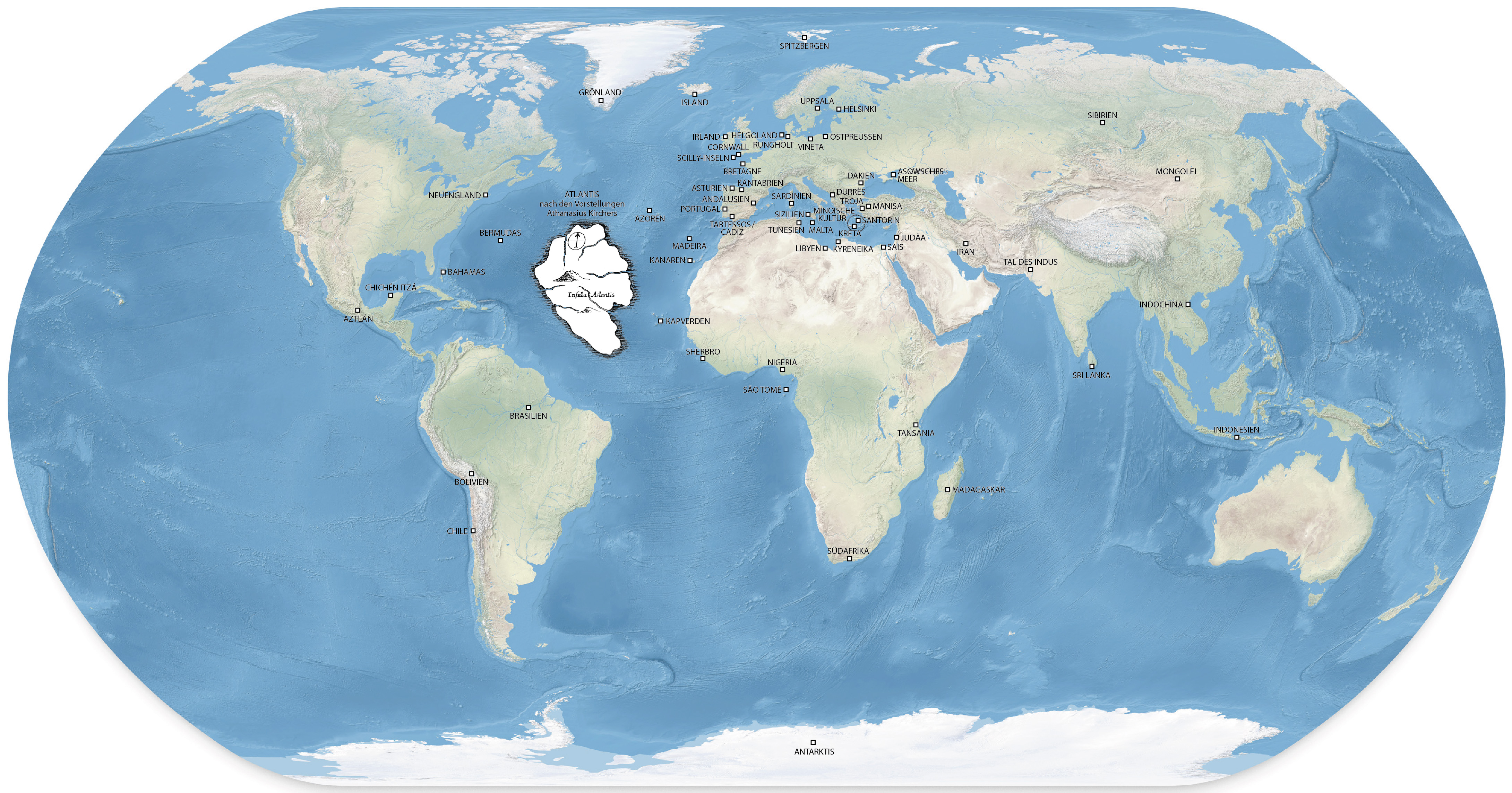There are scholars who maintain that Atlantis was first mentioned by Plato.
But references to the area designated as Atlantis are found in many cultures.
Atlantis was given its name by the Greeks after Atlas.
But early Greek legends indicate Sanatana Dharma, Hinduism connection.
Balarama, Krishna legends have found and there is a view that the Pillars of Hercules was made in honor of Lord Krishna.
Please check my posts by Googling the term and ramanan50.
Be that as it may.
Saka Dweepa is deemd to be Atlantis by taking reference to Sanskrit Texts.
Atala, one of the regions, out of 14,is a part of the nether world probably indicating that it lies, below, the equator( at least a portion of it).
‘
The Vishnu Purana, one of the oldest of the Hindu Puranas, speaks of “Atala, the White Island,” one of the seven dwipas (islands) belonging to Patala (Book II, chaps. i, ii, and iii). This ancient text locates Atala geographically on the seventh (heat, or climate) zone, which according to Francis Wilford (the translator) is 24 to 28 degrees north latitude, putting it in the same latitude as the Canary Islands just off the North African coast. Col. Wilford rightly calls Atala, “Atlantis, the White Island”. (Wilford, 1808)
At least one “authority” has attempted to identify Atala with Italy, but Italy is not an island. Also, Italy is 38 to 45 degrees north latitude. Finally, I fail to see any possibility that the “Western Ocean,” mentioned in the texts as its location, could be the Mediterranean Sea when the Karna Parva of the Mahabharata clearly describes Africa as comprising that ocean’s eastern shoreline—placing that body of water clearly to the west of Africa!
Another non-Sanskrit scholar implies that Atala might be one of the well-known northern lands, such as Iceland or Greenland, and that the epithet “White Island” refers to its being covered with snow the majority of the time—even the mythological Hyperborea has been suggested. This does not appear to be the case.
Atala and Sveta Dwipa (“White Island”) are not the only names for Atlantis in Sankrit lore. Another name, Saka Dwipa, is used just as often in the Puranas; and according to the Sanskrit Dictionary (1974), Saka Dwipa means “island of fair skinned people.” It is therefore quite possible that “white” refers to the skin color of its inhabitants, rather than to the dominant color of the island—although it should not be assumed that all Atlanteans were white-skinned.
The terms “Atala” and “White Island” are used also by the Bhavishya Purana (4th cent. B.C.). Here it is stated that Samba, having built a temple dedicated to Surya (the Sun), made a journey to Saka Dwipa, located “beyond the salt water” looking for the Magas (magicians), worshippers of the Sun. He is directed in his journey by Suryahimself (i.e., journeys west following the Sun), riding upon Garuda (the flying vehicle of Krishna and Vishnu) he lands at last among the Magas.
The Mahabharata (circa. 600 B.C.) also refers to “Atala, the White Island”, which is described as an “island of great splendour.” It continues: “The men that inhabit that island have complexions as white as the rays of the Moon and they are devoted to Narayana . . . Indeed, the denizens of White Island believe and worship only one God.” (Santi Parva, Section CCCXXXVII)‘
Although there are numerous ancient Egyptian king-lists in existence, only a few include the famous “reign of the gods”. These include the Palermo Stone (2565-2420 B.C.), the Turin Papyrus (1300 B.C.), and Manetho’s Egyptian Chronicles (250 B.C.). Of these, the Turin Papyrus is by far the most complete source.
The Turin Papyrus (Gardiner, 1987; Smith, 1872) lists ten kings who ruled during the “reign of the gods,” complimenting the fragments of Manetho which have come down to us. Most importantly, it informs us as to the correct number of actual kings, thus helping us to equate Egyptian names with the corresponding Greek names. Below is a list of god-kings from the Turin Papyrus, with Manetho’s fragmented list alongside:
| The Turin Papyrus | Manetho’s King-list |
|---|---|
| Ptah | Hephaestus |
| Ra | Helios |
| Su | Agathodaemon |
| Seb | Cronos |
| Osiris | Osiris |
| Set | Typhon |
| Horus | . . . |
| Thoth | . . . |
| Ma | . . . |
| Horus | Horus |
So we have ten Aulitean (or, Aletean) kings reigning in a “foreign land” during the precise time Plato says ten Atlantean kings reigned in Atlantis. The Turin Papyrus also records the installation of the next series of kings in 9850 B.C.! This date is so close to the date given for the end of Atlantis that coincidence is virtually out of the question. In such a case, the equation “Aletean=Atlantean” doesn’t seem out of the question. ‘
The Santi Parva also describes Atala as being inhabited by white men who never have to sleep or eat. (Ibid.) Interestingly enough, the Greek historian Herodotus (450 B.C.) describes a tribe of Atlanteans who “never dream and eat no living thing”. (History, Book IV) Can this be coincidence? And just as the god Poseidon is very much involved in the Atlantis story, likewise in the Sanskrit accounts we find Varuna (the Hindu Poseidon) very much involved in Atala.
In other words, Atala, the White Island is remarkably similar to Plato’s Atlantis, even down to its circular capital city, Tripura! Tripura is made in three concentric parts, just as Plato’s Metropolis is divided into three parts by concentric canals. During the war of the gods and Asuras, the wicked cities of the Asuras began to fall, one by one, amidst loud cries of woe: “Burning those Asuras, he [the hero] threw them down into the Western ocean” (Karna Parva, Section XXXIV).
Concerning the “concentric arrangment” of Tripura, a recent archeological discovery of a fortified palace in Bactria, India, known as Dashly-3, turned out to be a concentric 3-ringed structure of the “tripura type”. [Their words, not mine.] The archaeologists, excavating under the auspices of the Archaeological Departments of Pakistan and India (Mahadevan, 15), also state that the Dasyas, the builders of Dashly-3, were “Asura-worshippers”.
In the Surya Siddhanta, an ancient Sanskrit text on astronomy, the translator (W. D. Whitney, 1860) mentions an “island” (dwipa) called Jambu Dwipa, surrounded by rings of alternating land and water. I am tempted to equate Jambu Dwipa with the Atlantean capital, which Plato describes as surrounded by circular canals, “making alternate zones of sea and land” (Critias)…
For instance, it has been alledged that Plato called Atlantis “a continent,” whereas Atala was only an island; therefore, it is reasoned, they could not be one and the same.
In actual fact, Plato never calls Atlantis a continent: only a “large island”. That Atala is also a very large island can be deduced from the Mahabharata, which describes Atala as having a capital city (Tripura), other major cities with houses, palaces, and streets, and as being populated by numerous tribes, some of whom chose to wage war against other nations. This is not a description of a small island.‘
That whether it was an Island or a Continent is a non issue.
Continent may be a large mass surrounded by water.
Like Australia.
‘The Santi Parva also describes Atala as being inhabited by white men who never have to sleep or eat. (Ibid.) Interestingly enough, the Greek historian Herodotus (450 B.C.) describes a tribe of Atlanteans who “never dream and eat no living thing”. (History, Book IV) Can this be coincidence? And just as the god Poseidon is very much involved in the Atlantis story, likewise in the Sanskrit accounts we find Varuna (the Hindu Poseidon) very much involved in Atala.
In other words, Atala, the White Island is remarkably similar to Plato’s Atlantis, even down to its circular capital city, Tripura! Tripura is made in three concentric parts, just as Plato’s Metropolis is divided into three parts by concentric canals. During the war of the gods and Asuras, the wicked cities of the Asuras began to fall, one by one, amidst loud cries of woe: “Burning those Asuras, he [the hero] threw them down into the Western ocean” (Karna Parva, Section XXXIV).
Concerning the “concentric arrangment” of Tripura, a recent archeological discovery of a fortified palace in Bactria, India, known as Dashly-3, turned out to be a concentric 3-ringed structure of the “tripura type”. [Their words, not mine.] The archaeologists, excavating under the auspices of the Archaeological Departments of Pakistan and India (Mahadevan, 15), also state that the Dasyas, the builders of Dashly-3, were “Asura-worshippers”.
In the Surya Siddhanta, an ancient Sanskrit text on astronomy, the translator (W. D. Whitney, 1860) mentions an “island” (dwipa) called Jambu Dwipa, surrounded by rings of alternating land and water. I am tempted to equate Jambu Dwipa with the Atlantean capital, which Plato describes as surrounded by circular canals, “making alternate zones of sea and land” (Critias)’
Try this one!
‘
The term Asura means powerful.
While Ravana from the southern part of Bharatavarsha is called a Rakashsa, the people of Atala, Atlantis were called Asuras.
This term set me to search for a landmass which had a culture similar to Sanatana Dharma.
One finds references to this in the Ramayana where Sugriva directs hs army to search for Sita in Peru, identifying it with the Nazca Lines, which he called
as Shiva’s Trishul Mark, the Nazca Lines resemble the Trishul Mark.
The description of Tripura confirmed suspicion that Atlantis is Tripura mentioned in the Purana and destroyed by Lord Shiva.
“However, secondary tradition founded by people and limited in time, and the original tradition has superhuman origin and timeless nature. Because of this myth, and even the Bible texts “Egyptian Book of the Dead” is only secondary to the polar revelation contained in the text of “Avesta”, “Rig” and “Popol Vuh.”There is direct textual overlap between the myth of Tripura and dredaniem of Atlantis. First of all, ‘of course, we are talking about uniformity describe the appearance of Tripura and Atlantis. “Matsya Purana” and “Mahabharata” reported three round town, merged into one, and the first one was made of gold, the other – from the silver, and the third – of iron [29]. In turn, Plato in the dialogue “Critias” said a central island surrounded by the “alternate water and earth rings (earth was two, and water – three) all larger diameter, conducted as if the compass of the middle of the island, at equal distance from each other” [ 30]. Central island and two earthen ring – this is a description of a triple-like Tripura. The walls of each of these cities were covered with metal. The outer city wall was covered with copper, middle – tin, and the inner city – precious orichalcum. [31] The walls of the temple of Poseidon were lined with silver and gold. [32] Such detailed description of the matches in the Indian holy city of ancient myth and prove not only the relationship of the two stories, but the stories of historical authenticity.In other Indo-European sacred myths we find the same pattern. In “Avesta” description Vary, a town built on the orders of Yima Ahuramazda, fits the description of Atlantis and polar Tripura. ”
Tripura destroyed by Shiva Atlantis
Delhi Indraprastha Built by Builder from Atlantis
More to follow.





Leave a comment